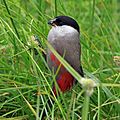Estrilda
Appearance
| Estrilda | |
|---|---|

| |
| Black-crowned waxbill (Estrilda nonnula) | |
| Scientific classification | |
| Domain: | Eukaryota |
| Kingdom: | Animalia |
| Phylum: | Chordata |
| Class: | Aves |
| Order: | Passeriformes |
| Family: | Estrildidae |
| Genus: | Estrilda Swainson, 1827 |
| Type species | |
| Loxia astrild Common waxbill Linnaeus, 1758
| |
Estrilda is a genus of estrildid finch in the family Estrildidae.
Most of the genus is found in Africa with one species, the Arabian waxbill, ranging into Asia.
Some species are kept as pets and have been accidentally introduced to various parts of the world.
Taxonomy
[edit]The genus Estrilda was introduced in 1827 by the English naturalist William John Swainson with the common waxbill as the type species.[1] The name of the genus is from astrild, the specific epithet of the common waxbill that was introduced by Carl Linnaeus in 1758.[2]
Species
[edit]The genus contains 11 species:[3]
| Image | Scientific name | Common Name | Distribution |
|---|---|---|---|
 |
Black-crowned waxbill | Estrilda nonnula | Nigeria and Cameroon to southeast Sudan, west Kenya and northwest Tanzania |
 |
Black-headed waxbill | Estrilda atricapilla | Angola, Burundi, Cameroon, the Republic of Congo, the Democratic Republic of the Congo, Equatorial Guinea, Gabon, Kenya, Rwanda and Uganda |
 |
Kandt's waxbill | Estrilda kandti | central Africa |
 |
Orange-cheeked waxbill | Estrilda melpoda | Angola, Benin, Bermuda, Burkina Faso, Burundi, Cameroon, Central African Republic, Chad, the Republic of Congo, Côte d'Ivoire, the Democratic Republic of the Congo, Equatorial Guinea, Gabon, Gambia, Ghana, Guinea, Guinea-Bissau, Liberia, Mali, Mauritania, Niger, Nigeria, Puerto Rico, Rwanda, Senegal, Sierra Leone, Togo, and Zambia |
| Anambra waxbill | Estrilda poliopareia | southern Nigeria | |
 |
Fawn-breasted waxbill | Estrilda paludicola | Angola, Burundi, Central African Republic, the Republic of Congo, the Democratic Republic of the Congo, Ethiopia, Gabon, Kenya, Rwanda, South Sudan, Tanzania, Uganda and Zambia |
 |
Common waxbill | Estrilda astrild | Sierra Leone, Liberia, Ivory Coast, Gabon, Nigeria, Namibia, Angola, South Africa, Botswana, Ethiopia, Tanzania, Malawi, Kenya, Uganda, Rwanda, Burundi, Mozambique, Cameroon |
| Black-lored waxbill | Estrilda nigriloris | Democratic Republic of the Congo | |
 |
Black-rumped waxbill | Estrilda troglodytes | Benin, Burkina Faso, Cameroon, Central African Republic, Chad, The Democratic Republic of the Congo, Côte d'Ivoire, Eritrea, Ethiopia, France (introduced by Guadeloupe), Gambia, Ghana, Guadeloupe, Guinea, Kenya, Liberia, Mali, Mauritania, Niger, Nigeria, Portugal (introduced), Puerto Rico, Senegal, Sudan, Togo, Uganda |
 |
Crimson-rumped waxbill | Estrilda rhodopyga | Burundi, The Democratic Republic of the Congo, Djibouti, Egypt, Eritrea, South Africa, Ethiopia, Kenya, Malawi, Rwanda, Somalia, Sudan, Tanzania and Uganda |
| Arabian waxbill | Estrilda rufibarba | Yemen and southwestern Saudi Arabia |
The genus formerly contained other species with "waxbill" in their common name that are now placed in the genera Coccopygia, Brunhilda and Glaucestrilda.[3]
References
[edit]- ^ Swainson, William John (1827). "On several groups and forms in ornithology, not hitherto defined". Zoological Journal. 3: 343–363 [349–350].
- ^ Jobling, James A. (2010). The Helm Dictionary of Scientific Bird Names. London: Christopher Helm. p. 151. ISBN 978-1-4081-2501-4.
- ^ a b Gill, Frank; Donsker, David; Rasmussen, Pamela, eds. (January 2023). "Waxbills, parrotfinches, munias, whydahs, Olive Warbler, accentors, pipits". IOC World Bird List Version 13.1. International Ornithologists' Union. Retrieved 10 February 2023.
